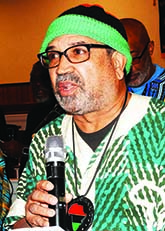
A Disturbing Trend: COVID-19 Is Disproportionately Infecting Afrikan Americans
By Makheru Bradley

Last week when US government officials identified the next five COVID-19 hotspots, which included Chicago, Detroit, New Orleans, and Atlanta, I anticipated that the virus would hit the Black community hard. Although the US Centers for Disease Control has not produced COVID-19 infection data by race, we are finally getting some state and local reports based on race and ethnicity, and what was anticipated has become the reality.
Charlotte-Mecklenburg
To its credit Mecklenburg County Public Health has been reporting demographic data on COVID-19 infections from their first reports. Black residents comprise 32.9% of Mecklenburg County’s population but are 43.7% of the reported COVID-19 cases, per the April 4 report. By comparison, white people are 57.5% of the county’s population, but they comprise only 29.2% of the cases. Hispanics are 13.6% of the population and 18% of the cases. One interesting trend in Charlotte-Mecklenburg is that 70. 7% of the cases are people between ages 20-59.
Cook County and Chicago
WBEZ reports: As of Saturday (April 4), 107 of Cook County’s 183 deaths from COVID-19 were black. In Chicago, 61 of the 86 recorded deaths – or 70% – were black residents. Blacks make up 29% of Chicago’s population. The majority of the black COVID-19 patients who died had underlying health conditions including respiratory problems and diabetes. Eighty-one percent of them had hypertension, or high blood pressure, diabetes or both.
As the virus continues to spread, the high mortality rate for black residents is alarming. “It’s disturbing and upsetting, but not surprising,” said Dr. Linda Rae Murray, health policy professor at the University of Illinois at Chicago. “This is just a reflection of the facts that we already know about these pandemics. People who are vulnerable will die quicker and won’t have as many resources.”
Historically, Chicago’s black communities have been disproportionately affected by health-related issues including poverty, environmental pollution, segregation and limited access to medical care.
Some of these historical factors are raising the risks for black residents in the coronavirus outbreak, said Murray, a former official in the Chicago Department of Health and previous chief medical officer for Cook County Public Health.
It can be more difficult for black residents to practice social distancing because the population is more likely to use public transit and hold jobs that can’t be done from home. In poorer communities in the city, persons of color are also more likely to live in crowded homes, experts say.
Michigan
The Metro Times reports: The coronavirus is infecting and killing an alarming proportion of Black residents in Michigan. Black people make up 12% of Michigan's population. But of the state’s 417 coronavirus deaths, 40% are Black, 26% are white, 30% are unknown, and 4% are mixed race or other, according to data released Thursday (April 2) by the Michigan Department of Health and Human Services.
Of the nearly 11,000 who tested positive for the coronavirus, 35% are Black, 25% white, 34% are unknown. An additional 6% represent other races. A quarter of the deaths and confirmed infections are in Detroit, where 80% of the population is Black.
Decades of economic inequality and systemic racism in Michigan have trapped a disproportionate number of Black people in poverty. And studies show that cities with concentrations of impoverished people are susceptible to higher infection and fatality rates. Many lower-income people rely on public transit, live in large apartment buildings, and work at jobs without paid sick days. At service industry jobs, employees often can't work remotely and are in close contact with the public. Another symptom of poverty is chronic illnesses due to unequal access to medical care.
Milwaukee
ProPublica reports: The coronavirus entered Milwaukee from a white, affluent suburb. Then it took root in the city’s black community and erupted. As of Friday morning, African Americans made up almost half of Milwaukee County’s 945 cases and 81% of its 27 deaths in a county whose population is 26% black. Milwaukee is one of the few places in the United States that is tracking the racial breakdown of people who have been infected by the novel coronavirus, offering a glimpse at the disproportionate destruction it is inflicting on black communities nationwide.
As the disease spread at a higher rate in the black community, it made an even deeper cut. Environmental, economic and political factors have compounded for generations, putting black people at higher risk of chronic conditions that leave lungs weak and immune systems vulnerable: asthma, heart disease, hypertension and diabetes. In Milwaukee, simply being black means your life expectancy is 14 years shorter, on average, than someone white.
Louisiana
CNN Reports: 32% of the population is African American however, those residents account for about 70% of coronavirus deaths. In New Orleans, the coroner's office and mortuaries have reached their limits, Mayor LaToya Cantrell said. She's asked the federal government for additional refrigeration. The New Orleans convention center, which sheltered Hurricane Katrina evacuees 15 years ago, has now been converted into an emergency hospital.
Albany-Dougherty County, GA
WALB reports: Of the 38 people who have died in Dougherty County, 81 percent have been African-American, and most have been women. The ages have ranged from 34 to 98-years-old. The Albany Metro Area has a population of almost 147,000 people. There are 681 people who have tested positive for COVID-19, and 39 have died. That means there are 27 deaths per 100,000 residents, one of the highest COVID-19 death rates in the United States.
Comparing Albany to Atlanta/Fulton County
The April 6 Georgia Department of Public Health COVID-19 Daily Status Report shows that Fulton County with a population of over 1 million people has 32 deaths compared to rural Dougherty County’s updated total of 44 deaths.
Social Distancing was not introduced soon enough
The source of the Albany cluster of COVID-19 cases is thought to be the February 29 funeral of Andrew Jerome Mitchell, what epidemiologists are calling a “super-spreading event,” in which a small number of people generate a huge number of infections. Mr. Mitchell’s sister assumes one of the guests brought the virus to her brother’s funeral, where “you hug and you kiss and you embrace.” The virus spread invisibly for 10 days before social distancing was introduced. By March 22, it was everywhere.
Why is this happening to Afrikan Americans?
Dr. Camara Jones, a family physician, epidemiologist and visiting fellow at Harvard University told ProPublica, “The reasons for this are the same reasons that African Americans have disproportionately high rates of maternal death, low levels of access to medical care and higher rates of asthma.”
“COVID is just unmasking the deep disinvestment in our communities, the historical injustices and the impact of residential segregation,” said Jones, who spent 13 years at the CDC, focused on identifying, measuring and addressing racial bias within the medical system. “This is the time to name racism as the cause of all of those things. The overrepresentation of people of color in poverty and white people in wealth is not just a happenstance. … It’s because we’re not valued.”
What can we do right now?
A massive struggle for real power, which positively impacts the psychological and physical conditions of Afrikan Americans is required to correct the health disparities in the US. However, there are things we can do, such as adjusting our lifestyles, eating healthier diets and getting more exercise. We must practice the social distancing rules, wear facemasks properly, and gloves while out in the public. With the pandemic here, we must to do everything possible, take vitamin supplements e.g., to keep our immune systems boosted up, so that if you contract COVID-19 your antibodies will prevent it from advancing to pneumonia. Most coronavirus patients who end up on ventilators do not survive, according to several studies from the U.S., China and Europe. Many of the patients who do survive can't be taken off the mechanical breathing machines. Our immune system is our best defense.
For more from the author, follow his blog Makheru Speaks.

